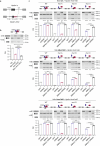Autism-related traits in myotonic dystrophy type 1 model mice are due to MBNL sequestration and RNA mis-splicing of autism-risk genes
- PMID: 40259070
- PMCID: PMC12148930
- DOI: 10.1038/s41593-025-01943-0
Autism-related traits in myotonic dystrophy type 1 model mice are due to MBNL sequestration and RNA mis-splicing of autism-risk genes
Abstract
Genome-wide enrichment of gene-specific tandem repeat expansions has been linked to autism spectrum disorder. One such mutation is the CTG tandem repeat expansion in the 3' untranslated region of the DMPK gene, which is known to cause myotonic muscular dystrophy type 1. Although there is a clear clinical association between autism and myotonic dystrophy, the molecular basis for this connection remains unknown. Here, we report that sequestration of MBNL splicing factors by mutant DMPK RNAs with expanded CUG repeats alters the RNA splicing patterns of autism-risk genes during brain development, particularly a class of autism-relevant microexons. We demonstrate that both DMPK-CTG expansion and Mbnl null mouse models recapitulate autism-relevant mis-splicing profiles, along with social behavioral deficits and altered responses to novelty. These findings support our model that myotonic dystrophy-associated autism arises from developmental mis-splicing of autism-risk genes.
© 2025. The Author(s).
Conflict of interest statement
Competing interests: M.S.S. is a Scientific Advisory Board member of Skyhawk Therapeutics and Tacit Therapeutics. The other authors declare no competing interests.
Figures

















Update of
-
Autistic traits in myotonic dystrophy type 1 due to MBNL inhibition and RNA mis-splicing.Res Sq [Preprint]. 2023 Aug 14:rs.3.rs-3221704. doi: 10.21203/rs.3.rs-3221704/v1. Res Sq. 2023. Update in: Nat Neurosci. 2025 Jun;28(6):1199-1212. doi: 10.1038/s41593-025-01943-0. PMID: 37645891 Free PMC article. Updated. Preprint.
References
-
- Soke, G. N., Maenner, M. J., Christensen, D., Kurzius-Spencer, M. & Schieve, L. A. Prevalence of co-occurring medical and behavioral conditions/symptoms among 4- and 8-year-old children with autism spectrum disorder in selected areas of the United States in 2010. J. Autism Dev. Disord.48, 2663–2676 (2018). - PMC - PubMed
MeSH terms
Substances
Grants and funding
- R01NS103172/U.S. Department of Health & Human Services | NIH | National Institute of Neurological Disorders and Stroke (NINDS)
- R01 MH094714/MH/NIMH NIH HHS/United States
- P20 GM103440/GM/NIGMS NIH HHS/United States
- R01 GM129325/GM/NIGMS NIH HHS/United States
- P50NS132955/U.S. Department of Health & Human Services | NIH | National Institute of Neurological Disorders and Stroke (NINDS)
- R15 NS124008/NS/NINDS NIH HHS/United States
- 2020/38/A/NZ3/00498/Narodowe Centrum Nauki (National Science Centre)
- P50 NS132955/NS/NINDS NIH HHS/United States
- FRN-148910/Gouvernement du Canada | Canadian Institutes of Health Research (Instituts de Recherche en Santé du Canada)
- FRN-173282/Gouvernement du Canada | Canadian Institutes of Health Research (Instituts de Recherche en Santé du Canada)
- MDA546770/Muscular Dystrophy Association (Muscular Dystrophy Association Inc.)
- R15NS124008/U.S. Department of Health & Human Services | NIH | National Institute of Neurological Disorders and Stroke (NINDS)
- P20 GM121325/GM/NIGMS NIH HHS/United States
- R16GM154702/U.S. Department of Health & Human Services | NIH | National Institute of General Medical Sciences (NIGMS)
- 2020/39/D/NZ3/01658/Narodowe Centrum Nauki (National Science Centre)
- R16 GM154702/GM/NIGMS NIH HHS/United States
- R01 NS103172/NS/NINDS NIH HHS/United States
LinkOut - more resources
Full Text Sources

